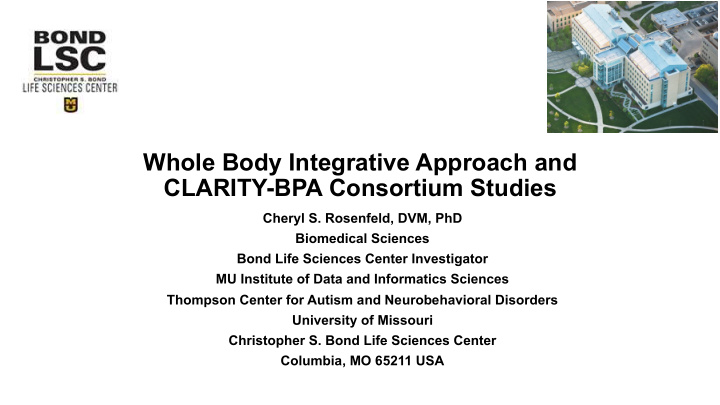



Whole Body Integrative Approach and CLARITY-BPA Consortium Studies Cheryl S. Rosenfeld, DVM, PhD Biomedical Sciences Bond Life Sciences Center Investigator MU Institute of Data and Informatics Sciences Thompson Center for Autism and Neurobehavioral Disorders University of Missouri Christopher S. Bond Life Sciences Center Columbia, MO 65211 USA
CLARITY-BPA Consortium Studies • This Consortium project involved 13 independent investigators and many of them received tissues from the same animals. • Independent investigators have published their own data that clearly shows that even low dose exposure to bisphenol A (BPA) leads to harmful effects in the organ/system studied. • One of the key goals though established at the outset of the studies was to integrate results across studies. • However, the FDA and NTP has yet to do such analyses. • In our current publication (Heindel et al., Repro Toxicol, 2020), we report on a method, mixOmics analyses, that integrates datasets across laboratories for three ages (juvenile, young adult, and older adult) and three doses of BPA (2.5 mg/kg, 250 mg/kg, and 2500 mg/kg body weight).
Types of Correlation Analyses Correlating More than Two Factors
MixOmics Analysis • “ We introduce mixOmics . By adopting a systems biology approach, the toolkit provides a wide range of methods that statistically integrate several data sets . This method allows for simultaneous correlation analyses to permit “ data integration across independent studies .” Rohart et al., Plos Comp Biol 2017 13(11):e1005752 . • It is thus designed to compare heterogenous and large datasets. • As mentioned above, it was also designed with the idea of comparing datasets across independent studies. • We have used it to integrate ’omics and phenotypic data ( Marshall et al. J Endocrinol 2019; Mao et al., PNAS 2020; Butler et al., J Neuroendocrinol 2020; Kaur et al., Sci Reports 2020 ). • To our knowledge, though, this is the first usage of this program to integrate datasets from multiple independent laboratories.
Diablo “R” Plot Marshall et al., J Endocrinol 2019
Circos Plot Marshall et al., J AIN Endocrinol 2019 GEN
R Plot 6-month-old female data for low-dose BPA exposure (2.5 µ g/kg/day) and controls Heindel et al., Repro Toxicol 2020
Circos Plot: 6-month-old female data for low-dose BPA exposure (2.5 µ g/kg/day) and controls Heindel et al., Repro Toxicol 2020
MixOmics data integration comparison at 2.5, 250 and 2500 g µ /kg/day of BPA at PND180 in females Correlation coefficient Phenotype A Phenotype B BPA2.5 BPA250 BPA2500 Macrophages within white White adipose tissue results adipose tissue 0.54 ND 0.03 White adipose tissue weight 0.84 0.75 0.75 Heart results 0.58 0.6 0.65 Mammary gland results 0.82 0.51 0.64 Peptide hormones 0.67 0.54 0.61 Steroid hormones 0.54 0.13 0.3 Uterine results 0.57 0.37 0.3 Splenic function results 0.69 0.51 0.53 Macrophages within white adipose tissue White adipose tissue weight 0.71 0.77 0.35 Ovarian follicle results 0.51 0.25 0.29 Heart results 0.54 0.7 0.23 Mammary gland results 0.67 0.87 0.22 Peptide hormones 0.66 0.74 0.34 Steroid hormones 0.78 0.52 0.17 Uterine results 0.72 -0.06 0.06 Splenic function results 0.65 0.37 0.53 White adipose tissue weight Ovarian follicle results 0.55 0.42 0.62 Heart results 0.67 0.67 0.55 Mammary gland results 0.93 0.88 0.78 Peptide hormones 0.7 0.86 0.87 Steroid hormones 0.59 0.5 0.68 Uterine results 0.86 0.29 0.24 Splenic function results 0.87 0.61 0.78 Ovarian follicle results Heart results 0.4 0.22 0.52
MixOmics data integration comparison at 2.5, 250 and 2500 g µ /kg/day of BPA at PND180 in females Correlation coefficient Phenotype A Phenotype B BPA2.5 BPA250 BPA2500 Splenic function results 0.87 0.61 0.78 Macrophages within white Ovarian follicle results Heart results 0.4 0.22 0.52 Mammary gland results 0.6 0.31 0.89 Peptide hormones 0.81 0.58 0.64 Steroid hormones 0.25 0.37 0.75 Uterine results 0.51 0.6 0.68 Splenic function results 0.47 0.66 0.62 Heart results Mammary gland results 0.66 0.59 0.64 Peptide hormones 0.41 0.77 0.58 Uterine results 0.61 0.32 0.26 Splenic function results 0.82 0.61 0.69 Mammary gland results Peptide hormones 0.72 0.8 0.74 Steroid hormones 0.55 0.52 0.69 Uterine results 0.73 0.05 0.66 Splenic function results 0.8 0.43 0.66 Peptide hormones Steroid hormones 0.61 0.48 0.55 Splenic function results 0.56 0.78 0.82
R plot correlations across 6-month-old male data for low-dose BPA exposure (2.5 µ g/ kg/day) and controls. Heindel et al., Repro Toxicol 2020
Circos Plot: 6-month-old male data for low-dose BPA exposure (2.5 µ g/kg/day) and controls Heindel et al., Repro Toxicol 2020
MixOmics data integration comparison at 2.5, 250 and 2500 µ g/kg/day of BPA at PND180 in males. Correlation coefficient Phenotype A Phenotype B BPA2.5 BPA250 BPA2500 White adipose tissue results Adipose tissue weight 0.55 0.71 0.74 Heart results 0.17 0.4 0.57 Splenic function results 0.62 0.67 0.72 Macrophage in white adipose tissue Prostate results 0.28 0.58 ND Adipose tissue weight Heart results 0.68 0.73 0.66 Peptide hormones 0.39 0.72 0.45 Prostate results 0.57 0.85 ND Splenic function results 0.7 0.81 0.56 Heart results Peptide hormones 0.42 0.66 0.27 Prostate results 0.65 0.69 ND Splenic function results 0.5 0.72 0.69 Peptide hormones Splenic function results 0.82 0.66 0.76 Prostate results Splenic function results 0.6 0.7 ND
Rethinking How We View Organ Systems and Effects of BPA on the Human Body Old Way New Way Adipose Tissue Adipose Tissue
Conclusions • To our knowledge, the current work represents the first study to use this informatics approach to integrate data across multiple independent investigator labs . • By using a whole body integrative approach, it reveals that even low doses of BPA currently considered safe by the FDA can simultaneously lead to effects in multiple organs in both males and females and at all ages studied. • The most surprising correlations were those associated with BPA- exposure, the immune system, and other systems in both females and males. • The main limitation of the mixOmics approach is that it can only establish correlation. However, follow-up studies can then be designed to determine which BPA-induced changes may be precipitating factors and lead to systemic consequences.
Recommend
More recommend